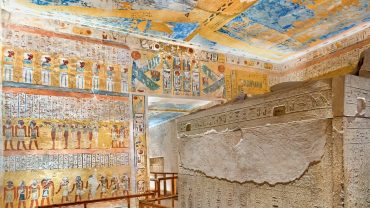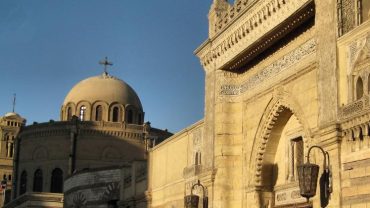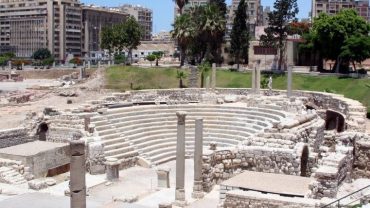The Hanging church | El Muallaqa Church | Suspended Church | Coptic Cairo
The Hanging Church also referred to as the Suspended Church or Al-Muallaqa is one of the oldest churches in Egypt and the history of a church on this site dates to the 2nd century AD.
Hanging Church location
The church is located on the east bank of the Nile River, in an area known as Coptic Cairo on the southern gate of the Roman Fortress. Here, we can still see the oldest Islamic Mosque of Amr Ibn El Ass and the Jewish Synagogue of Ben Ezra.
The reason behind the name Hanging Church?
The hanging church (El Muallaqa) drives its name from its location on the top of the southern tower gate of the old Babylon fortress, the Roman fortress in Old Cairo.
Importance of the Hanging Church
It is the most famous Coptic Christian church in Cairo, as well as the first built in Basilican style.
When the Hanging Church was built?
it was probably built during the Patriarchate of Isaac (690-692). Though an earlier church building may have existed elsewhere as earlier as the 3rd or the 4th century
However, the earliest mention of the church was a statement in the biography of the patriarch Joseph (831- 849) when the governor of Egypt visited the establishment.
The Church was largely rebuilt during (975-978) by the patriarch Abraham and has seen many other restorations including one very recently after which objects of historical interest that were no longer of service went to the Coptic Museum.
Marian apparition
The church is the site of several reported apparitions of Mary. she is said to have appeared in a dream to the Coptic Pope Abraham in the 1970 AD in the story of how the Muqattam mountains were moved by faith.
The Seat of Coptic Pope, El Muallaqa
by the 11th century AD, it became the official residence of the Coptic patriarch of Alexandria. with the reign of the Patriarchate of Christodoulou (1047-1077). there was a conflict between the church of Saints Sergius and Bacchus and El Muallaqa church broke out due to the wishes of that Patriarch’s desire to be consecrated in the Hanging church, a ceremony that traditionally took place at the church of saints Sergius and Bacchus.
Nevertheless, Christodoulous was consecrated at El Muallaqa as well as several others after him including Cyril II and Michael IV (1092-1102). Other Patriarchs were either enthroned or elected at El Muallaqa. And a number of others were buried at the church during the 11th and 12th centuries.
Also, Coptic synods were held in the church to determine which day Easter would fall or to judge priests or bishops suspected of heretical teachings.
Description of the Hanging Church
The church measures 23.5 m long,18 m wide, and 10 m high and can be reached by 29 Steps. it became known to travelers during the 14th and 15th centuries as the staircase church because of these steps which in turn led to an open court.
The entrance to the church lies in the south on the east wall of the narthex, which is an outer Porch decorated with geometric and floral designs and a relief applied to the Stucco.
Hugging Church plan
The church was originally built in a traditional Basilican plan with 3 aisles, a narthex, and a tripartite sanctuary.
The Little Church
Another chapel was built as an altar and known as the little church constructed over the eastern tower of the Babylon fortress, south gateway. It now represents the oldest part of the remaining church. Later on, during the 19th century, a fourth aisle was added.
The main body of the current church with its notable timber wagon-vaulted roof features a central nave and two narrow aisles separated by 8 columns on each side.
between the nave and the north aisle is a row of 3 columns spanned by wide Lancet arches. the columns between the Aisles are made out of white marble with an exception of one black basalt. some of these capitals are Corinthian, and so were probably removed from an older building.
Within the Nave was a tank boarded up now, which once was used for food washing on Maunday Thursday and on the Feast of Saints Peter and Saint Paul.
There is also a marble Ambon(pulpit), which dates from the 11th century. so, some of its white and colored marble may predate the pulpit itself.
It surmounts 15 graceful columns. the southern marble façade of the pulpit’s steps is carved with a design showing a shell and a cross on the stairs, representing the Resurrection of Christ.
Hanging Church Sanctuaries
there are three Haikals(sanctuaries) within the eastern section of the church.
The central one is dedicated to the Virgin Mary, the Northern left to saints George and the southern right one to send John Baptist.
The central Haikal screen is made out of ebony inlaid with ivory and carved into segments showing geometric designs and crosses, dating from the 12th or the 13th century. On the top of it is a row of 7 large icons.
The center of these icons depicts Christ seated on a throne. To his right is the Virgin Mary and the Angel Gabriel and saints Peter. while to his left are John the Baptist, the angel Michael and Saints Paul.
within the Sanctuary, the altar is surmounted by a canopy supported by four columns and behind the altar is a marble tribune where the clergy usually set.
The northern Haikal screen has a design of squares with crosses that are alternately ivory and ebony, and the crosses at the top of it are 17 icons representing different scenes from the martyrdom of St George.
The southern screen shows a cruciform pattern and dates from the 13th century. Atop of it are 7 small icons that depict the life of St John the Baptist.
However, all of these icons are the work of a single Armenian artist. Orhan Karabedian and were executed in 1777.
Entrance to the little Church
within the church’s southern aisle is a small door of fine pine wood inlaid with translucent ivory plating. this leads to the little church actually a chapel which represents the oldest section of the structure. the Haikal screen here dates to the 13th century. A fine wall painting on the east wall probably represents Christ flanked by the apostles. and the during the restoration that took place in 1984, a beautiful wall scene was also discovered.
All the columns of these chapels were adorned with paintings. Today only the scene on the fifth column from the east in the southern row is visible. it probably depicts a female saint possibly a queen or a princess.
Baptistery of the Hanging Church
Just to this south of this sanctuary is the baptistery Witch house a Deep round basin of red granite and a niche adorned with mosaic.
patriarch Michael IV extended this upper floor for use as accommodation for the patriarch.
Though, now in the Coptic Museum and the oldest artifact unearthed in the church was a lintel showing Christ’s entry into Jerusalem which dates either from the 5th or the 6th century.
However, so there are many objects from the church in the Coptic Museum. inside the church are a collection of over 100 icons which is the oldest dating from the 8th century.
For more information about Christianity and Coptic Churches in Egypt, please visit
Christian History in Egypt




Comment (0)